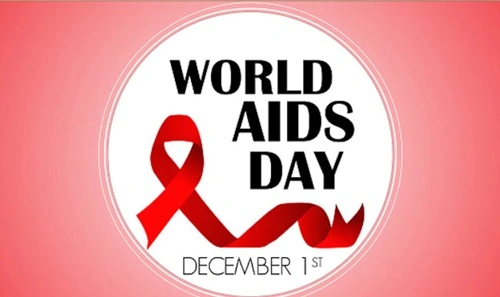World AIDS Day, observed annually on December 1, is a global initiative to raise awareness about the HIV/AIDS epidemic, support those living with the disease, and remember the lives lost to AIDS-related illnesses. Established in 1988, this day serves as a vital platform to promote understanding, reduce stigma, and encourage progress toward eliminating HIV/AIDS as a public health threat.
Here’s everything you need to know about World AIDS Day, its history, significance, and the ongoing global fight against HIV/AIDS.
History and Origins

World AIDS Day was the first-ever global health day, initiated by James W. Bunn and Thomas Netter, two public information officers at the World Health Organization (WHO). Their idea was endorsed by Dr. Jonathan Mann, the Director of WHO’s Global Programme on AIDS, and the first observance took place on December 1, 1988.
The choice of the date was strategic—it falls between major US holidays like Thanksgiving and Christmas, ensuring media and public attention. Over the years, World AIDS Day has evolved into a cornerstone of advocacy, driving awareness and action in the fight against HIV/AIDS.
Significance of World AIDS Day
HIV/AIDS has claimed more than 40 million lives worldwide since the epidemic began, and approximately 38.4 million people were living with HIV at the end of 2021. World AIDS Day serves several critical purposes:
- Raising Awareness: Educating the global community about the realities of HIV/AIDS, including prevention, treatment, and the challenges faced by those living with the virus.
- Reducing Stigma: Combatting discrimination and myths surrounding HIV/AIDS to promote a more inclusive society.
- Honoring Lives Lost: Remembering those who have died from AIDS-related illnesses and celebrating the resilience of people living with HIV.
- Encouraging Action: Mobilizing governments, organizations, and individuals to support programs aimed at eliminating the disease.
The Global Impact of HIV/AIDS
HIV (Human Immunodeficiency Virus) attacks the immune system, making individuals more vulnerable to infections and diseases. Without treatment, it can lead to AIDS (Acquired Immunodeficiency Syndrome). While advancements in antiretroviral therapy (ART) have transformed HIV into a manageable chronic condition for many, challenges remain.
Key Statistics (as of 2021):
- New Infections: 1.5 million people were newly infected with HIV in 2021.
- Access to Treatment: 75% of people living with HIV had access to ART.
- Deaths: 650,000 people died from AIDS-related illnesses in 2021.
While significant progress has been made, inequalities in access to healthcare and education continue to hinder efforts to end the epidemic.
Themes of World AIDS Day
Each year, World AIDS Day adopts a specific theme to address pressing issues in the global fight against HIV/AIDS. Recent themes include:
- 2022: “Equalize” – Highlighting the need to address inequalities that perpetuate the epidemic.
- 2021: “End Inequalities. End AIDS” – Emphasizing the importance of equitable healthcare access.
- 2020: “Global Solidarity, Shared Responsibility” – Recognizing the collective efforts needed to combat HIV/AIDS amidst the COVID-19 pandemic.
These themes reflect the evolving challenges and priorities in the global response to HIV/AIDS.
Challenges in Combating HIV/AIDS
Despite progress, several challenges remain in the fight against HIV/AIDS:
- Stigma and Discrimination: Many people living with HIV face social exclusion, which discourages them from seeking testing and treatment.
- Inequitable Access to Healthcare: Low- and middle-income countries often lack the resources needed to provide comprehensive care and treatment.
- Education Gaps: Misinformation about HIV transmission and prevention persists in many communities.
- Youth Vulnerability: Young people, especially in sub-Saharan Africa, remain disproportionately affected by new HIV infections.
Global Efforts and Initiatives
The fight against HIV/AIDS is bolstered by numerous international initiatives and partnerships:
- UNAIDS (Joint United Nations Programme on HIV/AIDS): Established in 1996, UNAIDS leads global efforts to end the AIDS epidemic by 2030.
- Global Fund to Fight AIDS, Tuberculosis, and Malaria: A partnership that funds programs to combat these diseases in low- and middle-income countries.
- 90-90-90 Targets: A UNAIDS initiative aiming for 90% of people living with HIV to know their status, 90% of those diagnosed to receive treatment, and 90% of those on treatment to achieve viral suppression.
- PEPFAR (President’s Emergency Plan for AIDS Relief): A US government initiative providing funding and support for HIV/AIDS programs globally.
How World AIDS Day is Observed
World AIDS Day is marked by activities and campaigns worldwide to raise awareness, support those living with HIV, and remember those who have died:
- Community Events: Vigils, marches, and public gatherings bring people together to show solidarity.
- Education Campaigns: Schools, universities, and organizations host workshops and discussions to educate people about HIV prevention and treatment.
- Testing Drives: Many organizations offer free HIV testing on this day to encourage early detection and treatment.
- Media Outreach: Social media campaigns, documentaries, and stories amplify the voices of those living with HIV and promote awareness.
The red ribbon, a universal symbol of support for people living with HIV, is widely worn and displayed during these observances.
How You Can Contribute
There are several ways individuals can make a difference on World AIDS Day and beyond:
- Get Tested: Knowing your status is the first step toward prevention or treatment.
- Educate Yourself and Others: Share accurate information about HIV prevention and treatment to combat myths and stigma.
- Support Advocacy Groups: Donate to or volunteer with organizations working to fight HIV/AIDS.
- Raise Awareness: Use social media to share messages of solidarity and promote access to healthcare.
Looking Ahead: Ending the Epidemic
The global commitment to ending HIV/AIDS by 2030 as part of the Sustainable Development Goals (SDG 3) remains a significant challenge but is achievable with concerted effort. Key priorities include:
- Expanding access to testing and treatment.
- Addressing inequalities in healthcare systems.
- Investing in education and prevention programs.
- Supporting innovation, such as vaccines and long-acting therapies.
Conclusion
World AIDS Day is more than a day of remembrance; it is a call to action. It reminds us of the progress made in the fight against HIV/AIDS while highlighting the work that remains. By raising awareness, combating stigma, and advocating for equitable access to healthcare, we can move closer to a future free from the burden of HIV/AIDS. Together, let us stand in solidarity with those affected and work toward a healthier, more inclusive world.

